Disassembling the drum of the Indesit washing machine
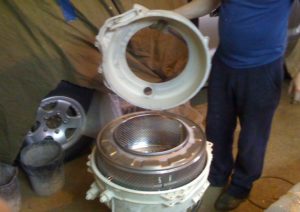 The washing machine tank contains vital parts that allow the moving units to rotate smoothly. When they wear out, extraneous sounds occur during spinning, as well as play. Unfortunately, the breakdown of these parts is not a rare occurrence, so we will talk about fixing them in this article. For example, we will learn how to disassemble the drum of an Indesit machine and replace the bearings on it.
The washing machine tank contains vital parts that allow the moving units to rotate smoothly. When they wear out, extraneous sounds occur during spinning, as well as play. Unfortunately, the breakdown of these parts is not a rare occurrence, so we will talk about fixing them in this article. For example, we will learn how to disassemble the drum of an Indesit machine and replace the bearings on it.
Is it worth undertaking repairs?
Wear of bearing units is one of the most common reasons for improper operation of a washing machine. Due to the fact that they allow the drum to rotate, a high load is placed on them, causing them to deteriorate faster than other parts and components. The bearing units are located on the drum cover, so we need to not only get to the tank, but also completely disassemble it. In general, you will have to perform an almost complete disassembly of the entire washing machine.
However, even disassembling the drum will not seem such a difficult task compared to disassembling a non-separable tank. Some manufacturers merge the tank with the drum, which makes it impossible to disassemble it manually. In this case, repair shops and service centers usually offer tank replacement. The problem is that its price can be up to 70% of the cost of a washing machine, so it makes more sense to buy a new “home assistant”.
If you don’t want to spend money on replacing the tank, much less replacing the entire washing machine, you can try sawing the tank with a metal saw (and then gluing it after replacing the parts).You can save serious money, but DIY repairs will require time and skill. If you're still keen to give it a try, below we'll cover everything you need to know.
We'll collect everything you need
Before you begin, you need to collect (or purchase) the necessary tools. By the way, the tools for repairing Ariston brand washing machines are the same, since Indesits and Aristons are similar in internal design. So, we will need:
- metal saw/hacksaw;
- marker;
- pliers and pliers;
- open-end wrenches 8-18 mm;
- set of heads with knobs;
- Phillips and straight screwdrivers;
- set of socket wrenches;
- hammer;
- multimeter;
- awl.
If you need to repair electrical parts of the machine, you can exclude the multimeter from the list. Use a regular tester.
Before disassembly begins
First we need some free space. If the machine is in a combined bathroom, there may be enough space, but if the bathroom is only “one meter by one meter,” there will be a lot of inconvenience when disassembling and repairing it. The best option is to move the device to the garage or outside (if you are doing repairs at the dacha). If this is not possible, move the washing machine to any room where there is at least 2 square meters. m of free space. Next, you need to do the following work.
- Cover your work area with scrap cloth or newspaper.
- Move the washing machine to your workplace, having first disconnected the hoses and wires from it.
- Disconnect the powder receiver from the machine - it will only get in the way.
- Drain the remaining water from the tank by unscrewing the drain filter (located at the bottom).
Also prepare a separate area for small parts and detachable parts. You can immediately put a powder receptacle and a filter there.
Getting to the tank
If the preparation is complete, you can begin the analysis.First of all, remove the cover. To do this, you need to unscrew the bolts from the back wall to which the cover is attached, and then pull it towards you and up. Nothing complicated.
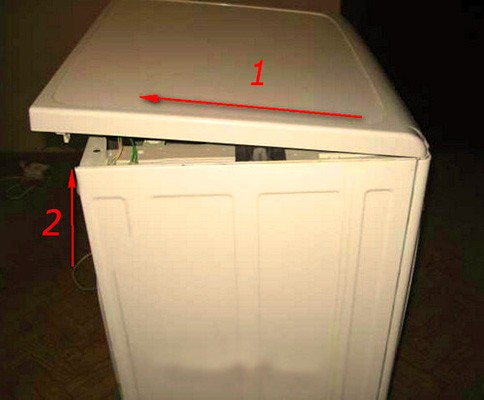
Next, you need to remove the hatch from the back of the washing machine. It is held together with several bolts - they need to be removed with the right screwdriver. We remove the front and back panels and see the internal parts of the device. When we remove them, we will get to the tank itself.
Let's start with the drive belt. To remove it, you need to hold the pulley with one hand and the belt with the other. Next, turn the pulley and wait for the belt to slip off.

Look at the wall behind the pulley. If there are rusty smudges or oil stains on it, then the bearings will definitely have to be changed. So let's continue the analysis. You need to find a heating element (tubular electric heater), its tail can be seen under the tank. You need to remove all the wiring from the heating element, and then remove the nut, which is located in the center of the shank between the contacts. Next, remove the heater from the groove.
Technically, you can disassemble the washing machine without removing the heating element. However, this may lead to damage to the contacts during disassembly, which in turn will require a complete replacement of the part.
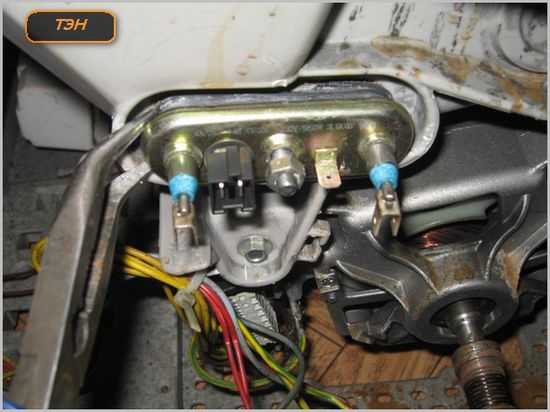
Next, remove the electric motor. We remove the chips and electrical wiring from it, unscrew the bolts, and then remove the engine and put it aside. Let's move on to the top. Manufacturers place a counterweight under the top wall, the purpose of which is to dampen the centrifugal force during washing and spinning. The counterweight looks like a large stone. Essentially, the counterweight is just a large stone. You can remove it using a socket wrench by removing the bolts on which it is attached. Set the counterweight aside.
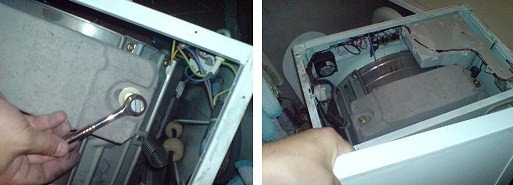
The counterweight is quite heavy, so be careful when removing it.
We've almost reached the tank itself. Next you need to remove the control panel. Proceed as follows:
- remove the fasteners located at the powder dispenser;
- go to the front of the washing machine, there is another fastener on the left, remove it as well;
- now the block is held only by latches; to disconnect the block from them, pull it up (act smoothly and carefully, otherwise there is a risk of breaking the wiring);
- disconnect the wires connecting the control panel and the inlet valve;
- put the part away with the rest of the removed parts; if there is a service hook, it will be even better.
Now you need to access the tank from the front. We begin to remove the cuff. Find the clamp that holds the rubber seal. Pry it off with a screwdriver (it is better to use the thinnest one available). Using a screwdriver, go around the clamp until you feel the fastening. Unscrew the fastening. Remove the clamp. Thread the rubber band into the drum.
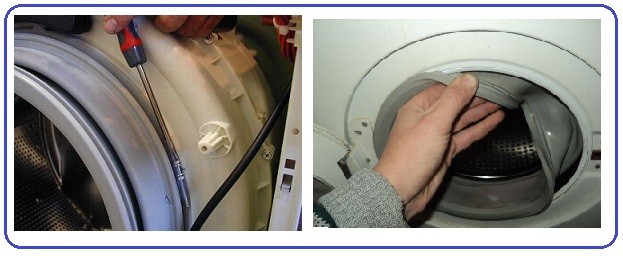
There is a fastener at the back of the machine, next to the fill hose - you need to unscrew it. Next, we take out the inlet valve and the receiver niche for detergents.
In order to reach the receiver niche, disconnect the pipe by releasing the clamp.
Let's move on to the pressure switch. We disconnect the wiring from it, and then disconnect it from the mount. The mount itself is plastic, so be careful when removing the sensor - it can be easily damaged.
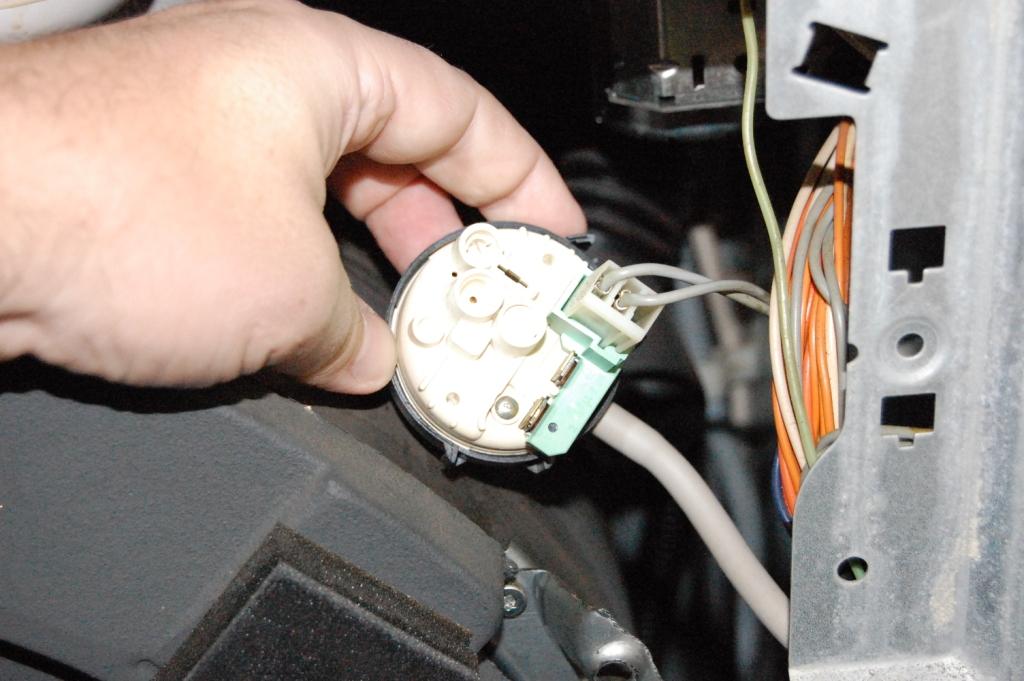
Before removing the stand pipe and drain, place the “home assistant” horizontally. As a rule, Indesit models do not have a bottom, so you will see the necessary part right away. We remove the pipe clamps. To do this, simply loosen the fastening element.
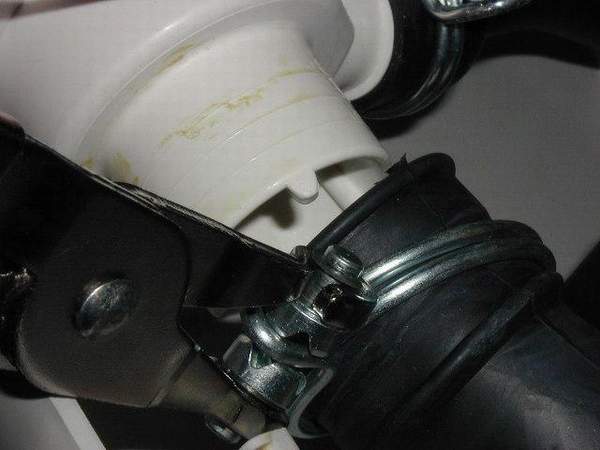
Using a 10mm socket wrench, unscrew the fasteners holding the posts in place and then remove them. After this, you can put the washing machine upright again - we have reached the tank and can start cutting it.
Cutting the tank
Of course, you can’t saw the tank inside the body - first, take it out from there. You may not have enough strength alone, so involve another pair of hands in the repair. When the tank is disconnected from the main body, you need to very carefully, trying not to damage the drum and other parts, cut it into two parts along the seam. To do this, perform a number of necessary manipulations. Place the tank vertically, with the seam you will be sawing facing towards you. The tank can be mounted on a washing machine tire to provide stability.
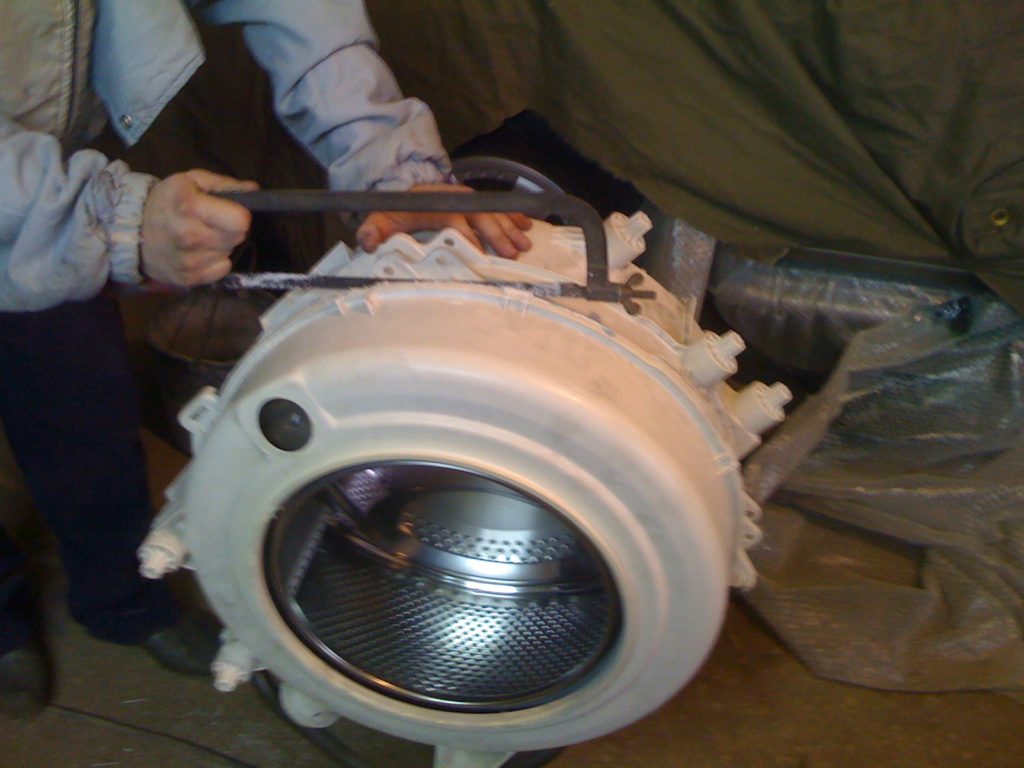
Make sure the tank is soldered and sawing is really necessary. If this is the case, cut the tank strictly along the seam. After sawing, remove and set aside the top of the tank. The back remains attached to the drum for now. The bearings are located there, so it will also have to be removed.
Getting to the bearings
Unlike the top part of the tank, the bottom part is not so easy to remove after cutting - it is a whole process. First, unscrew the nut holding the drum pulley. Next, do the following:
- remove the pulley;
- screw a bolt into the thread (no need to use a bolt from a machine - a screwed-in bolt will most likely be damaged);
- Place the rubber piece from the mallet on the bolt. If you don’t have one, you can use a wooden block or something similar;
- Tap the block or mallet with a hammer until the bottom half moves. If this does not happen, wet the area near the bolt with WD-40 and tap again with a hammer.
Once you get rid of this half of the tank, you will have full access to the drum. The bearings are located on the shaft. You can remove them using a washing machine puller. If it is not there, take the drum to a washing machine repair shop and they will help you disassemble the washing machine drum.
When the bearings are removed, you can install new ones and put the washing machine back together. Use sealant and bolts to reconnect the tank. We won’t describe how to put the washing machine back together - everything is the same as during disassembly, but in reverse order.
Interesting:
1 reader comment

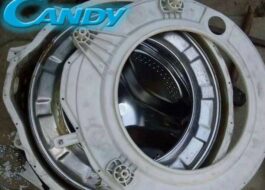
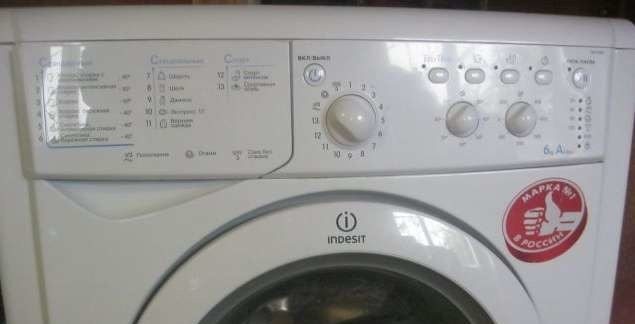
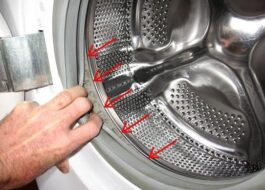
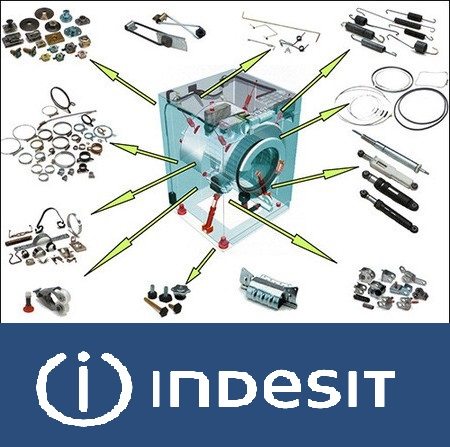

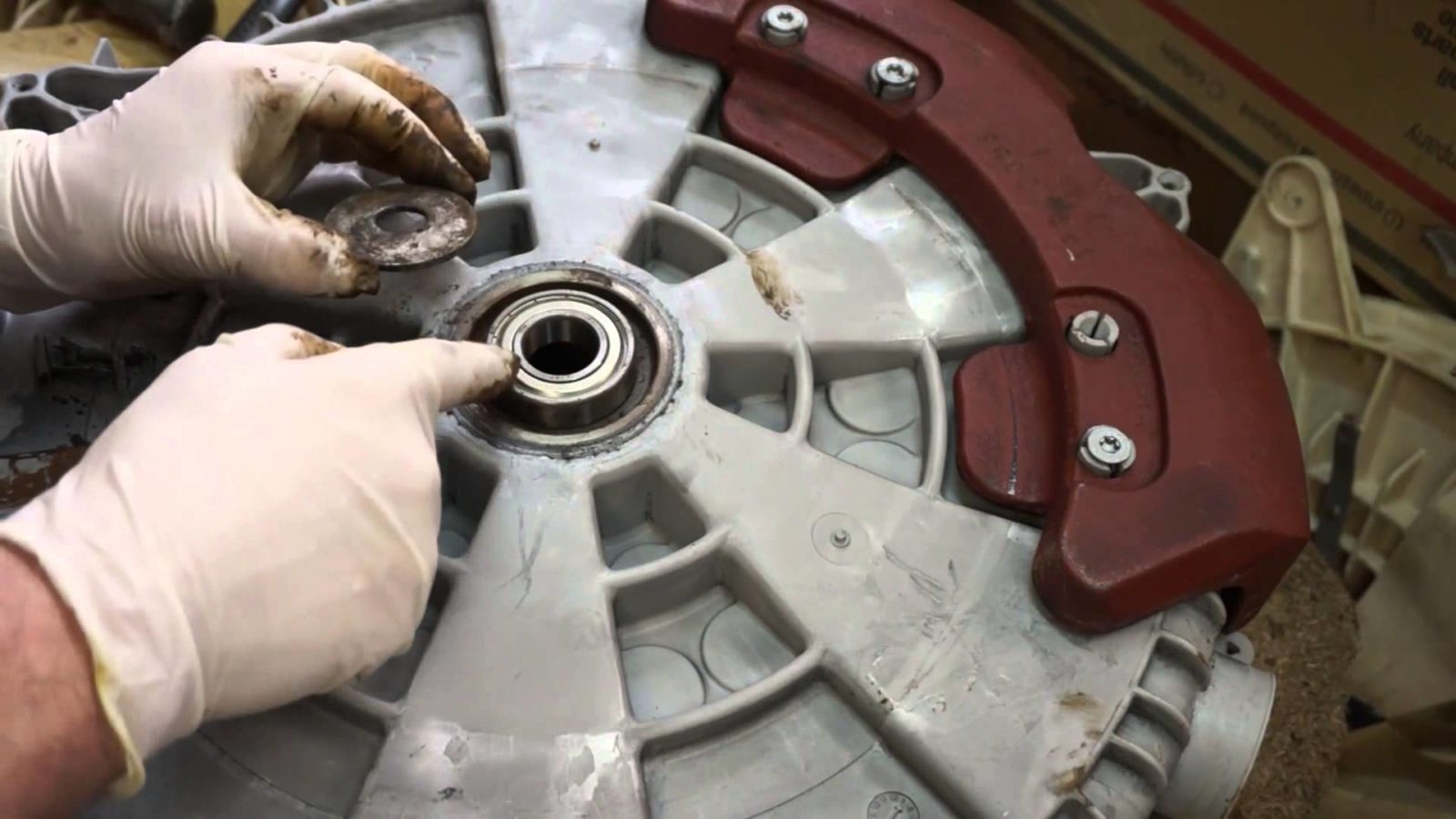














Everything is extremely clear and intelligible. Thanks for the help.